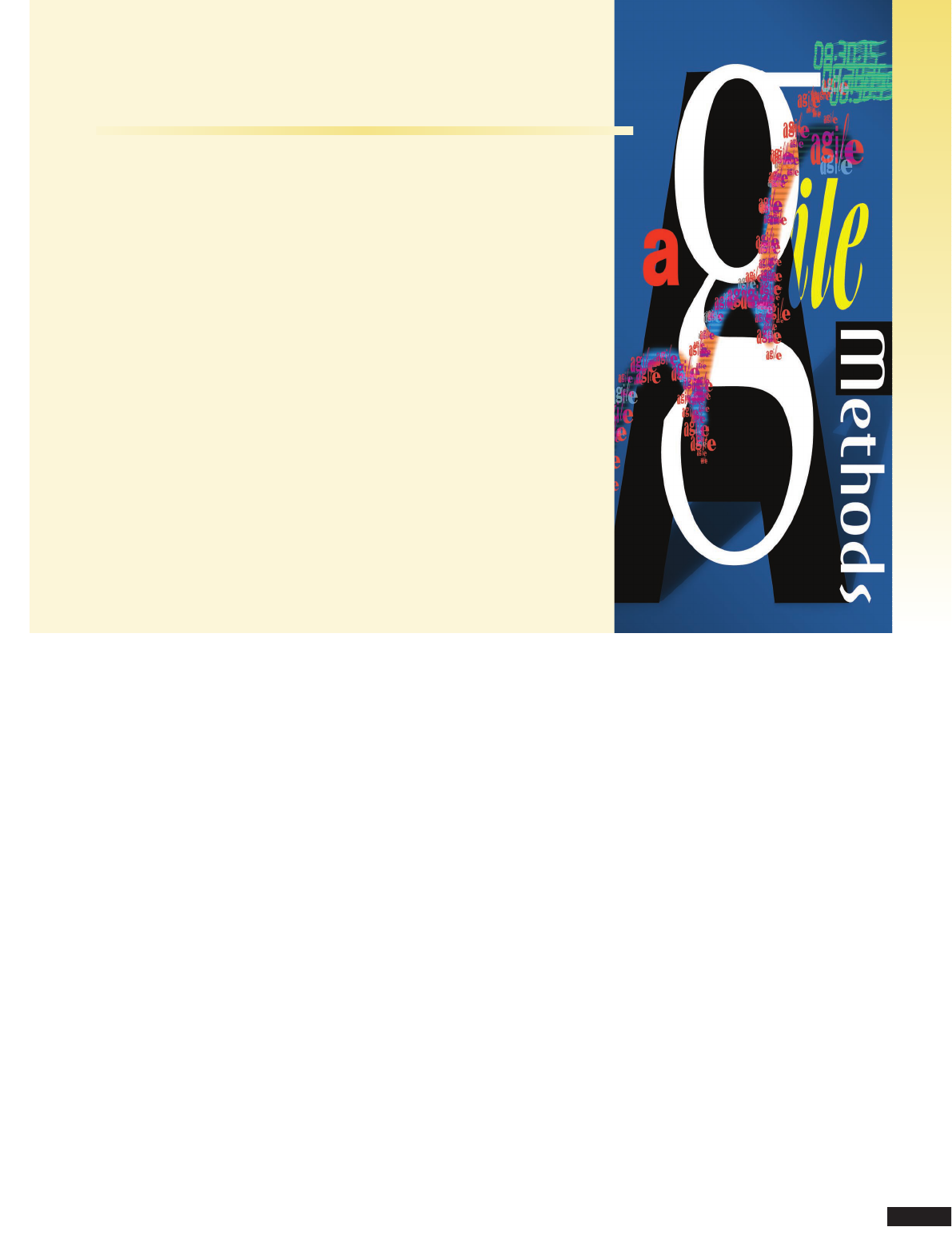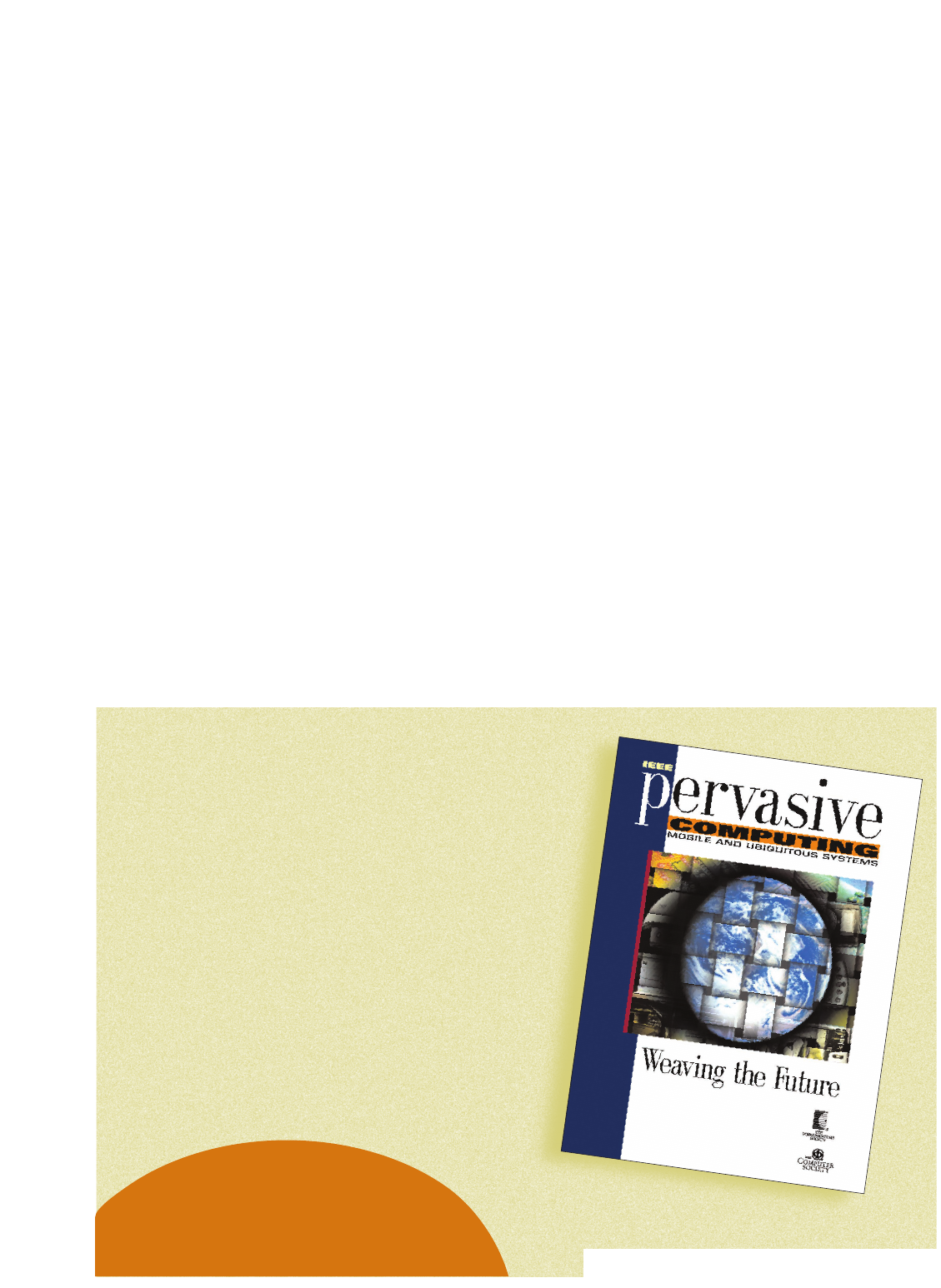
0018-9162/03/$17.00 © 2003 IEEE June 2003 39
GUEST EDITORS’ INTRODUCTION
Agile Software
Development:
It’s about
Feedback
and Change
ilarities, these practitioners authored their method-
ologies independently.
Underlying values
In February 2001, 17 of these practitioners and
authors met in Snowbird, Utah, to discuss the fun-
damental similarities of their experiences and their
then-called lightweight methodologies.
2
Finding that
their work habits had much in common, they rec-
ognized that the lightness in their work process pro-
vided a means to achieve the more relevant end:
customer satisfaction and high quality. They cate-
gorized their methodologies as “agile”—a term with
a decade of use in flexible manufacturing practices.
The participants wrote the “Manifesto for Agile
Software Development” (www.agilemanifesto.org),
which describes the four comparative values under-
lying the agile position:
• individuals and interactions over processes and
tools,
• working software over comprehensive docu-
mentation,
• customer collaboration over contract negotia-
tion, and
• responding to change over following a plan.
These four comparative values recognize the impor-
tance of the items on the right of each comparison,
Currently, the focus is on determining how to
blend agile methodologies with plan-driven
approaches to software development.
Laurie
Williams
North Carolina State
University
Alistair
Cockburn
Humans and
Technology
A
gile software development has hit a nerve
in the software development community.
Some people argue vociferously for it, oth-
ers argue equally against it, and others are
working to mix agile and plan-driven
approaches. Many more people wonder just what
agility is.
WHAT IS AGILITY?
In many development methods, particularly plan-
driven ones, work begins with soliciting and docu-
menting a complete set of requirements. Beginning
in the mid-1990s, many found this initial require-
ments documentation step frustrating and, perhaps,
impossible.
1
Both technology and the business envi-
ronment kept shifting during the project, and both
the requirements and project plans got out of date
within even relatively short projects. Customers
became increasingly unable to definitively state their
needs up front.
As a result, practitioners developed methodolo-
gies and practices to embrace, rather than reject,
higher rates of change. These methodologies were
developed on three different continents: the
Dynamic Systems Development Method in Europe;
Feature-Driven Development in Australia; and
Extreme Programming, Crystal, Adaptive Software
Development, and Scrum in the US. Although their
practices and philosophies shared fundamental sim-
Published by the IEEE Computer Society

40 Computer
but assert the dominance of the ones on
the left.
Empirical versus defined processes
Another point of commonality for all
agile methods is the recognition of software
development as an empirical (or nonlinear)
process. In engineering, processes are classi-
fied as defined or empirical.
3
A defined process
is one that can be started and allowed to run
to completion, producing the same results
every time.
4
Assembling an automobile is such
a process. Engineers can design a process to
assemble the car and specify an assembly
order and actions on the part of the assembly-line
workers, machines, and robots. Generally speak-
ing, if the manufacturing process follows these pre-
defined steps, it will produce a high-quality car.
Software development cannot be considered a
defined process because too much change occurs
during the time that the team is developing the
product. It is highly unlikely that any set of prede-
fined steps will lead to a desirable, predictable out-
come because requirements change, technology
changes, people are added and taken off the team,
and so on.
In an engineering context, empirical processes
necessitate short “inspect-and-adapt” cycles and
frequent, short feedback loops.
4
These short
inspect-and-adapt cycles can help agile method-
ologies better handle the software industry’s con-
flicting and unpredictable demands.
Other empirical methods that are in synch with
the Agile Manifesto can also be considered agile.
Agility, would-be agility, and various competitive
counterparts have become hot topics in conferences
and magazines—including IEEE Computer Society
publications.
5-8
There are now both books and
annual international conferences on the topic.
CURRENT CONVERSATIONS
As practitioners have gained experience with the
use of agile methods, the focus of their conversa-
tions about this approach to software development
has changed.
Suitable circumstances
In 2001, the conversation around agile was: What
is it really? Is it old, new, a fad, crazy, or what?
We found that agile development is not particu-
larly new. Software developers have been sporadi-
cally using the techniques since at least the 1960s.
What is new, if anything, is the bundling of the tech-
niques into a theoretical and practical framework
and the strong, sometimes vehement, declaration
of their importance.
In 2001, enough sample projects had been col-
lected to make the case that agile development
works under “suitable circumstances.” These cir-
cumstances generally can be categorized as non-
safety-critical projects with volatile requirements,
built by relatively small and skilled colocated teams.
Scalability
In 2002, the agile conversation focused on two
questions: How do we make it scale beyond these
“suitable circumstances?” Does agility contradict
the Software Engineering Institute’s Capability
Maturity Model and ISO 9000 rules?
A few projects of several hundred people have
used the agile framework succesfully.
9
However, dur-
ing 2002, agile practitioners and other researchers
concluded that the agile value set and practices best
suit colocated teams of about 50 people or fewer
who have easy access to user and business experts
and are developing projects that are not life-critical.
Although the agile value set might be adopted (and
may be adapted) under other circumstances, the
boundary conditions for truly agile behavior seem
to be fairly set.
A close but liberal reading of the CMM reveals
little that would prevent CMM-concerned teams
from using agile methods.
10
However, some com-
mon CMM practices are at odds with the agile
value set because of their reliance on processes,
plans, and delivering to original contract.
Generally, people willing to spend the money on
CMM certification are less interested in the agile
value proposition, while those needing agility for
business reasons are less interested in getting CMM
or ISO 9000 certification.
Adaptability
In 2003, the conversation has changed again:
Can we blend selected agile practices with our “reg-
ular” practices? How much change is necessary
when transitioning to and using agile methods?
How can agile practices improve the quality of our
products?
Development groups are trying pair program-
ming without any other agile practices, test-first
development without pair programming, and short
delivery cycles without pair programming or test-
first development, and trying to determine how to
get any of these practices to work with interna-
tionally distributed teams. Researchers worldwide
are gathering these agile subset experiences and
designing and staging additional experiments to
A point of
commonality for
all agile methods
is the recognition
of software
development
as an empirical
process.

empirically assess the efficacy of isolated practices
or agile subsets.
We see agile philosophies and practices dispersed
over a wider range of people, projects, and organi-
zations. For example, many CMM and ISO 9000
organizations now think that partial adoption of
agile practices, when handled with care, might
increase their efficiencies without damaging their
certifications.
Making changes
As agile development spreads from the early
adopters to a larger population of developers and
development managers, the question of change is
coming to the fore.
Agile development carries with it the implication
of changing work habits. For those who have not
used agile techniques, the change involves trying
out and selecting appropriate ones. For those
already using some of the techniques, the change
involves adjusting and improving their use over
time. Some proportion of the development com-
munity has no interest in change, however, which
may impose an inevitable limit to the penetration
of agile techniques.
Agile development can affect the power structure
within an organization because it spreads out the
decision-making authority. Executives are expected
to make and take accountability for business-level
decisions, deferring to the developers on technical
issues such as development techniques and time
estimates. The developers are then accountable for
these issues.
This decision-making approach differs from
what we see in many organizations. In some, the
programmers make many key decisions, including
those pertaining to business, process, and systems
requirements, while their managers either happily
or reluctantly go along for the ride. In other orga-
nizations, programmers have limited decision-mak-
ing authority, and they are treated as little more
than clerical workers.
In either case, the move to agile development,
with its reallocation of decision-making authority
and accountability, can cause consternation. We
encounter managers who report that they consider
agile development to be a license for developers to
hack, but we also encounter developers who con-
tend that agility is merely a ploy to let managers
micromanage their work. Just how to handle this
power shift remains an open question.
Finally, some question the ability of agile prac-
tices to improve product quality. Agile practices
stress early involvement of test groups and the need
for rapid feedback, but they don’t say much
about the relationship between the develop-
ment and quality assurance groups. Integrat-
ing quality assurance into projects to enhance
their agility requires making changes in the
relationship between these groups and even
in hiring practices.
IN THIS ISSUE
The articles in this issue capture some
results from earlier conversations and set the
stage for new ones.
In their short and colorful “Agility through
Discipline: A Debate,” Kent Beck and Barry Boehm
suggest that agile and plan-driven development
exist in different ecological niches and that each
will thrive or dominate depending on the “current
weather conditions.” Somewhere between the ele-
phant, the monkey, the mouse, and the dinosaur,
their debate conveys the message that both
approaches require discipline to work—although
with some different shadings of what discipline
means—and that each works well in specific
circumstances.
Craig Larman and Vic Basili’s article, “Iterative
and Incremental Development: A Brief History,”
traces this cornerstone agile practice back to the
1950s and even before. They cite NASA’s 1957
Mercury project, which used half-day increments,
and a 1969 report to IBM management that recog-
nized “the futility of separating design, evaluation,
and documentation processes in software-system
design.” Their article includes a quote from Gerald
Weinberg, who writes of an experience at about this
time “where the technique used was, as far as I can
tell, indistinguishable from XP.”
Barry Boehm and Rich Turner examine the agile
versus plan-driven debate and provide recommen-
dations for how and when to mix the two
approaches. In “Using Risk to Balance Agile and
Plan-Driven Methods,” they highlight both the
home grounds and risks associated with each
approach. They describe how they would choose
which approach to use and under what circum-
stances they would mix them, highlighting their
ideas with three sample projects that should use
different combinations of agile and plan-driven
practices. They characterize the projects using a
five-point radial diagram that isolates important
project features driving this decision. The diagram
also captures some part of the organization’s abil-
ity to undertake change.
Boehm and Turner list three categories of risk
that can affect the choice of how heavily to bias a
June 2003 41
Integrating
quality assurance
into projects
to enhance
their agility
requires making
changes.

42 Computer
project toward the agile or plan-driven side:
• risks stemming from an agile approach:
scalability, criticality, design simplicity,
staff churn, and staff skills;
• risks stemming from a plan-driven
approach: emerging requirements, con-
stant change, need for rapid results, and
staff skills; and
• general environmental risks: technology
uncertainties, diverse stakeholders, and
complex systems.
In listing these risks, they establish a frame-
work for examining the project experiences and
characteristics of various development approaches,
a framework echoed in the other three articles.
In “Developing Complex Projects Using XP with
Extensions,” Martin Lippert and his coauthors
describe how they have dealt with circumstances
encountered on projects using (mostly) Extreme
Programming. There is an echo of the Boehm-
Turner list in this work, even though the authors
arrived at their cyclical approach to software devel-
opment independently, based on specific project
experiences.
The authors discuss how they handled diverse and
conflicting interest groups driving a project, lack of
testing on the customer’s side of the equation, com-
plex systems and imprecise requirements, long-term
planning, dependencies among nonprogramming
tasks, and the need for requirements definition at
least for funding purposes. It is refreshing that they
identify the special skills the people in key roles
need, including the product manager, the author-
critic, and even the customer. Their experiences pro-
vide additional practices for agile developers to
consider using and demonstrate the benefits of mix-
ing selected traditional approaches with standard
agile and situationally derived practices.
In “Introducing an Agile Process to an Organi-
zation,” Mike Cohn and Doris Ford describe their
experiences with introducing Scrum into seven orga-
nizations over a four-year period and reflect on what
they learned along the way. They describe watch-
ing some developers add formal documents back
into their work practices—“we invariably found
programmers who enjoy producing noncode arti-
facts far more than they are willing to admit”—and
recall other overzealous developers who view agile
development as meaning they must not think ahead.
In light of the Beck-Boehm debate around disci-
pline, Cohn and Ford provide an interesting descrip-
tion: “They did not have the discipline XP requires
and, while paying lip service to XP, they were actu-
ally doing nothing more than hacking.” These
authors discuss their experiences with some Boehm-
Turner issues such as distributed development and
describe other issues that popped up on their pro-
jects, such as encountering developer resistance to
lightening the process, working with the human
resources department, using testers, and managing
the project and its interfaces to other groups.
Finally, in “Migrating Agile Methods to
Standardized Development Practice,” Mark Lycett
and his coauthors address a new wrinkle to intro-
ducing agile processes into an organization: work-
ing in an ISO 9000 or CMMI environment or one
in which a large corporation has mandated that all
projects must use a common process. They make
clear the need for a company to establish quality of
product, process, and service while still letting dif-
ferent projects work in the various ways that suit
them best.
Reporting on their experiences with a large com-
pany, these authors describe their particular
approach to project-specific process tailoring: a set
of process “patterns” that can be mapped to the
CMMI framework. For ISO 9000, they adopted a
pattern-based framework “to supplant repeatabil-
ity with consistency, while providing the audit trail
necessary for assessment.” For good project-
specific results, they revisited their use of the pat-
terns after each iteration and found that “making
the decision process visible is extremely valuable
because it forces management to actively determine
whether an activity or artifact is both necessary and
sufficient.” Echoing and extending the first Agile
Manifesto value, they describe their framework as
“suggesting suitable techniques for collaboration,
interaction, and communication.”
Lycett and his coauthors offer their own resolu-
tion of the agile versus engineering debate: “Agile
process does not fly in the face of engineering prac-
tice. If used thoughtfully, it provides a clear man-
date for making engineering practice lean and well
focused.”
I
t is a pleasure to introduce these articles in this
special issue. They capture the state of the cur-
rent conversation, and we hope they serve as the
catalyst for future ones. ■
References
1. J. Highsmith, Agile Software Development Ecosys-
tems, Addison-Wesley, 2002.
Working in an
environment in
which all projects
must use a
common process
adds a new wrinkle
to introducing
agile processes.

2. M. Fowler and J. Highsmith, “The Agile Manifesto,”
Software Development, Aug. 2001, pp. 28-32.
3. B.A. Ogunnaike and W.H. Ray, Process Dynamics,
Modeling, and Control, Oxford Univ. Press, 1994.
4. K. Schwaber and M. Beedle, Agile Software Devel-
opment with SCRUM, Prentice Hall, 2002.
5. B. Boehm, “Get Ready for Agile Methods, with
Care,” Computer, Jan. 2002, pp. 64-69.
6. A. Cockburn and J. Highsmith, “Agile Software
Development: The People Factor,” Computer, Nov.
2001, pp. 131-133.
7. J. Highsmith and A. Cockburn, “Agile Software
Development: The Business of Innovation,” Com-
puter, Sept. 2001, pp. 120-122.
8. L. Williams, “The XP Programmer: The Few-Minutes
Programmer” (guest editor’s introduction), IEEE
Software, May/June 2003, pp. 16-20.
9. R. Crocker, Large-Scale Agile Software Development,
Addison-Wesley, 2003.
10. M. Paulk, “Extreme Programming from a CMM Per-
spective,” IEEE Software, Nov./Dec., 2001, pp. 19-26.
Laurie Williams is an assistant professor of com-
puter science at North Carolina State University.
Her research interests include agile software devel-
opment methodologies and practices, software reli-
ability, software testing, and software engineering
for secure application development. She received a
PhD in computer science from the University of
Utah. Williams is the coauthor of Pair Program-
ming Illuminated and Extreme Programming Per-
spectives (both Addison-Wesley, 2003). She is a
member of the IEEE and the ACM. Contact her at
Alistair Cockburn, a coauthor of the “Manifesto
for Agile Software Development,” received a PhD
from the University of Oslo on the subject of peo-
ple and methodologies in software development.
He has published widely on formal specification,
object-oriented design, and development processes,
but is most widely recognized as the author of Writ-
ing Effective Use Cases and Agile Software Devel-
opment. Many of his publications are available
online at alistair.cockburn.us. Contact him at
I
EEE Pervasive Computing
delivers the latest peer-reviewed
developments in pervasive, mobile, and ubiquitous computing
and acts as a catalyst for realizing the vision of pervasive (or
ubiquitous) computing, described by Mark Weiser nearly a
decade ago. In 2003, look for articles on
•
Security & Privacy
•
The Human Experience
•
Building Systems That Deal with
Uncertainty
•
Interfacing with the Physical World
SUBSCRIBE NOW!
http://computer.org/pervasive
M. Satyanarayanan
Carnegie Mellon Univ. and Intel Research Pittsburgh
Associate EICs
IEEE Pervasive Computing
Editor in Chief
Roy Want, Intel Research; Tim Kindberg, HP Labs;
Deborah Estrin, UCLA; Gregory Abowd, GeorgiaTech.;
Nigel Davies, Lancaster University and Arizona University
